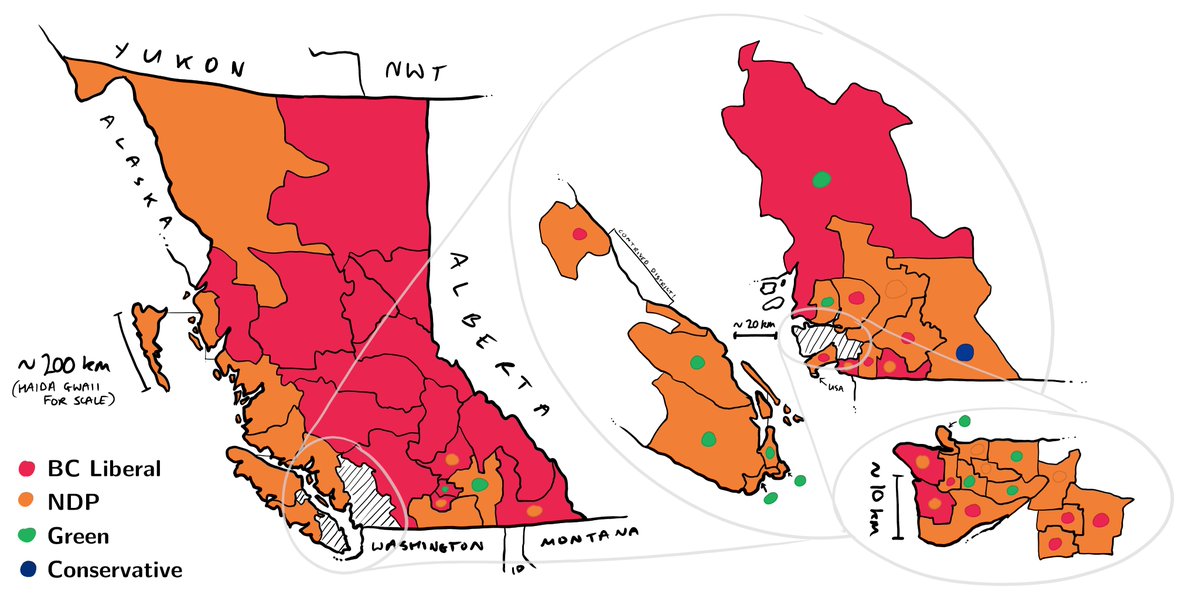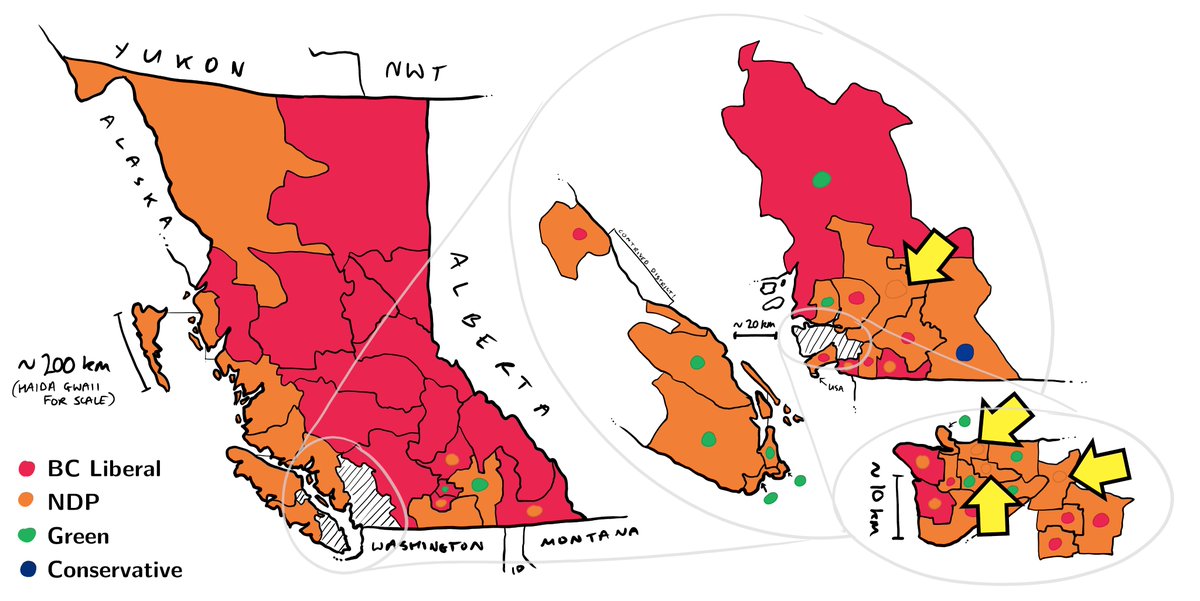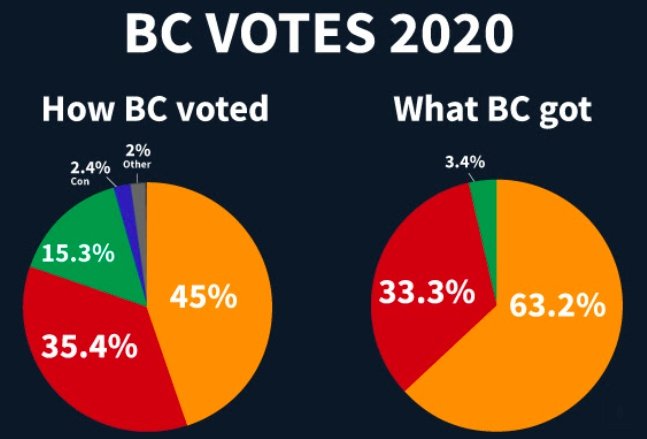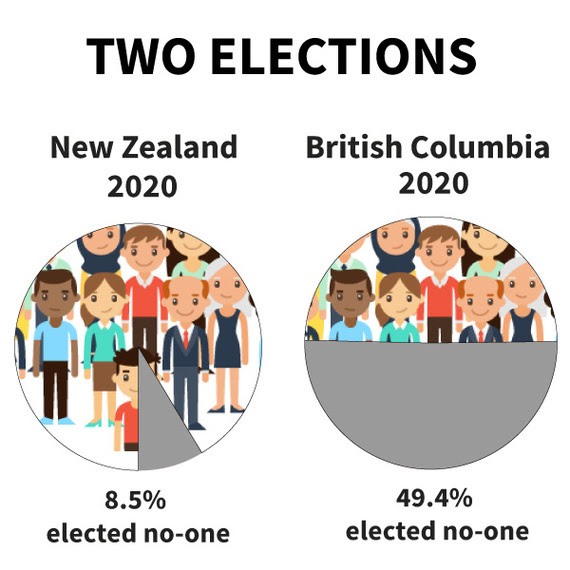Have you had your fill of politics south of the border? Want some escapism?
Then join me as we explore an alternate universe - the 2020 B.C. provincial general election that could have been.
Thread (1/20)
@FairVoteCanada @FairVoteVan @fairvotebc #bcpoli #DMP #electoralreform
Then join me as we explore an alternate universe - the 2020 B.C. provincial general election that could have been.
Thread (1/20)
@FairVoteCanada @FairVoteVan @fairvotebc #bcpoli #DMP #electoralreform
The scene: it is November 2020. The final votes are being counted in a historic provincial election.
This is the first to use a proportional system after the 2018 referendum on voting reform was won by the dark horse option - Dual Member Proportional voting. (2/20) #DMP
This is the first to use a proportional system after the 2018 referendum on voting reform was won by the dark horse option - Dual Member Proportional voting. (2/20) #DMP
For voters, the election experience was almost the same as before - all they had to do was put a cross in a box next to their preferred candidate(s). The main differences were in riding boundaries and the mathematics behind the scenes to get a proportional result. (3/20) #DMP
The new system was explained to BC residents in an information campaign, with video explainers similar to this:
(4/20) #electoralreform #bcpoli #dmp
(4/20) #electoralreform #bcpoli #dmp
70 of the 87 ridings in BC were merged to form new 2-seat districts, while 17 of the largest and least densely populated ridings remained as they were. (5/20)
#electoralreform #bcpoli #dmp
#electoralreform #bcpoli #dmp
With the final votes in, the proverbial lever was pulled and the numbers were crunched to calculate the final seat allocations - and this is how they turned out: (6/20)
#electoralreform #bcpoli #dmp @fairvotebc @FairVoteCanada @FairVoteVan
#electoralreform #bcpoli #dmp @fairvotebc @FairVoteCanada @FairVoteVan
In numbers:
VOTES
NDP - 47.7
Liberal - 33.8
Green - 15.1
Conservative - 1.9
Ind/oth - 1.5
SEATS
NDP - 43 (49.4%)
Liberal - 30 (34.5%)
Green - 13 (14.9%)
Conservative - 1 (1.1%)
(7/20)
#bcpoli #electoralreform #dmp @fairvotebc @FairVoteCanada @FairVoteVan
VOTES
NDP - 47.7
Liberal - 33.8
Green - 15.1
Conservative - 1.9
Ind/oth - 1.5
SEATS
NDP - 43 (49.4%)
Liberal - 30 (34.5%)
Green - 13 (14.9%)
Conservative - 1 (1.1%)
(7/20)
#bcpoli #electoralreform #dmp @fairvotebc @FairVoteCanada @FairVoteVan
The big winners were the BC Greens, who gained 10 seats from their 2017 baseline, across a much wider geographical area. Their success was mostly at the expense of the NDP, who would have expected a hefty majority if the province still used first-past-the-post. (8/20)
The NDP’s achievement should not be understated though - they nearly get a majority even in a proportional system, which is a very rare occurrence indeed. Indeed, they managed to win BOTH seats in 4 ridings! This demonstrates an astronomical level of local support. (9/20)
These 4 2-seat ridings were:
Port Coquitlam & Maple Ridge-Pitt Meadows,
Vancouver-Mount Pleasant & Hastings,
Vancouver-Kingsway & Burnaby-Deer Lake,
Surrey-Whalley & Coquitlam-Maillardville
(10/20)
Port Coquitlam & Maple Ridge-Pitt Meadows,
Vancouver-Mount Pleasant & Hastings,
Vancouver-Kingsway & Burnaby-Deer Lake,
Surrey-Whalley & Coquitlam-Maillardville
(10/20)
The BC Liberal party, despite underperforming in the popular vote, will be pleased to gain representation in a diverse range of ridings across the province, which can be used as a base to connect with voters in future elections. (11/20)
Even the Conservatives picked up a seat due to their strong local support in Chilliwack & Chilliwack-Kent.
[This is down to a quirk of my calculations. I didn’t include a province-wide 5% popular vote threshold for second seat eligibility, just to see what happens!] (12/20)
[This is down to a quirk of my calculations. I didn’t include a province-wide 5% popular vote threshold for second seat eligibility, just to see what happens!] (12/20)
In the end, the political situation in BC is very different, but oddly similar. There was a minority NDP government coming into the election, and there will be one afterwards. Whether the strengthened Green presence is a blessing or a curse for the NDP is yet to be seen! (13/20)
OK now *back to reality*.
How did I do this?
Because the way people vote under DMP is exactly the same as FPTP, votes cast under FPTP elections can be converted directly into DMP results without the need for a whole polling company’s resources. (14/20) #electoralreform #DMP
How did I do this?
Because the way people vote under DMP is exactly the same as FPTP, votes cast under FPTP elections can be converted directly into DMP results without the need for a whole polling company’s resources. (14/20) #electoralreform #DMP
(This assumes of course that people would vote exactly the same way in both systems, which is a whole other question.) (15/20)
#bcpoli #electoralreform #dmp @fairvotebc @FairVoteCanada @FairVoteVan
#bcpoli #electoralreform #dmp @fairvotebc @FairVoteCanada @FairVoteVan
Back in 2019 I put some code together to convert FPTP votes into DMP results, given pairs of districts to be merged together. If there is interest I can share the code, HOWEVER it is an absolute mess and would take a while to make presentable. (16/20)
#electoralreform #dmp
#electoralreform #dmp
What actually happened in the 2020 election? Firstly, it should never have happened! Under FPTP, governments have an incentive to call early elections if they are polling well as small swings in the popular vote can result in large majorities. (17/20)
And that's exactly what happened - we ended up with something like this. A false majority government on a minority of the vote, meaning a majority of BC voters are not represented in power.
(Graph from @fairvotebc) (18/20)
(Graph from @fairvotebc) (18/20)
Another way to look at this is to ask how many people are represented by an MLA they voted for? In BC, only 50% of voters are.
If DMP were used in 2020, this number would be 80% - still not perfect, but a huge improvement.
(Graphic from @fairvotebc) (19/20)
If DMP were used in 2020, this number would be 80% - still not perfect, but a huge improvement.
(Graphic from @fairvotebc) (19/20)
And to reiterate, these are the same voters and the same votes - just counting them differently!
Anyway, that’s about all I have for this thread. It’s already much longer than I thought. I can provide my code if asked for, but be prepared to wait for me to tidy it up! (20/20)
Anyway, that’s about all I have for this thread. It’s already much longer than I thought. I can provide my code if asked for, but be prepared to wait for me to tidy it up! (20/20)

 Read on Twitter
Read on Twitter

![Even the Conservatives picked up a seat due to their strong local support in Chilliwack & Chilliwack-Kent.[This is down to a quirk of my calculations. I didn’t include a province-wide 5% popular vote threshold for second seat eligibility, just to see what happens!] (12/20) Even the Conservatives picked up a seat due to their strong local support in Chilliwack & Chilliwack-Kent.[This is down to a quirk of my calculations. I didn’t include a province-wide 5% popular vote threshold for second seat eligibility, just to see what happens!] (12/20)](https://pbs.twimg.com/media/EsdZj4eUcAQ1rzX.jpg)




